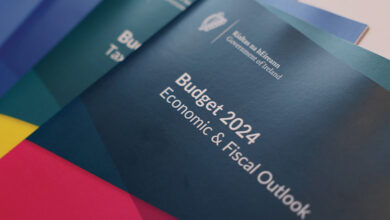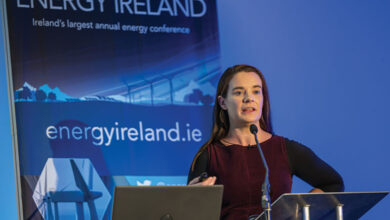Electricity to power the EU decarbonisation agenda
Writing for eolas, Eurelectric’s Secretary General, Hans ten Berge outlines how the European power sector is leading the transition to a low carbon future.
 The power sector is undergoing a complex and long-term transformation: accelerated technological change, shifting consumer preferences, the application of ICT technology to link power generation and demand as well as the evolving EU climate and energy policy agenda. These provide unprecedented challenges but also important opportunities for the sector.
The power sector is undergoing a complex and long-term transformation: accelerated technological change, shifting consumer preferences, the application of ICT technology to link power generation and demand as well as the evolving EU climate and energy policy agenda. These provide unprecedented challenges but also important opportunities for the sector.
Decarbonisation is essential to guarantee the long-term sustainability of the global economy and Europe’s electricity sector is fully committed to leading this transition. As a global leader in decarbonisation, the European power sector is committed to decarbonising power supply by 2050, and we are already taking important action. In 2014, 56 per cent of electricity in the EU came from low carbon sources. In the same year, the share of renewable energy sources (RES) in the power mix became the largest source of low carbon electricity in the EU, comprising 28 per cent of total power generation.
Market design
The real challenge is to create a holistic market design that delivers the technologies needed for a balanced low carbon energy mix, while being able to adapt to the evolving economics of power systems. The new market design, including a reformed and strengthened EU Emissions Trading System (ETS), must provide a solid basis for sustainable investment in low carbon technologies, ensuring in particular a robust business model for such investments. Only the combination of an effectively reformed EU ETS and an improved EU electricity market design can lead to proper price signals from the relevant markets to drive investments in mature low carbon technologies, allowing decarbonisation to take place in a cost-effective manner.
Meanwhile, in the midst of this energy transition, Europe needs to ensure secure, sustainable, affordable and competitive energy for all its citizens and businesses. The Energy Union project, based on its five mutually supportive dimensions (energy security; solidarity and trust; the internal energy market; energy efficiency as a contribution to the moderation of energy demand; decarbonisation of the economy; and research, innovation and competitiveness) is intended to address these challenges.
The European power sector sees immense potential in the Energy Union project and we fully support efforts to develop an ambitious, European approach to energy policy. This is an opportunity for member states to enhance security of supply, cost competitiveness and emission reductions in ways which individual countries cannot achieve on their own. EU institutions and member states should therefore work together to ensure that collective and national measures lead to the development of a decarbonised and fully competitive single market in energy.
The agreement reached last December at the COP21 UN Climate Change Conference in Paris should result in an ambitious and rules based climate change regime, which paves the way for a stable and predictable framework for policy and action. This agreement provides a clear and unequivocal signal to government and investors to invest in low-carbon technology in line with long-term decarbonisation objectives.
In this context, the power sector believes that the emissions trading system should be the main driver for RES investments in the electricity sector. Strengthening the emissions trading system is a no-regret option. With a reinforced carbon price signal and an accelerated cap reduction, additional measures to promote renewables can be minimised within the ETS sectors. The EU ETS, which is an established, technology-neutral, European wide instrument, can also bring an increasingly EU wide approach to low carbon technologies development and investment. If member states choose to continue to provide support for mature RES after 2020, it should be done in the most cost-efficient and market-based way.
Policy design
The Commission’s proposal to revise the EU ETS Directive puts the EU on course to take important steps on the path towards cost-effectively decarbonising the European economy. However, the success of the reformed EU ETS will depend on ensuring full consistency and coherence between the various elements and targets of the 2030 Climate and Energy Framework, as well as developing an adequate governance framework which enables the achievement of these objectives.
European policies and implementing instruments must therefore be designed in a way that does not undermine the overall economic efficiency and environmental effectiveness of the EU ETS. Coherent and integrated policy instruments based on a well-functioning EU ETS will be crucial to achieve the EU’s greenhouse gas emission reduction targets on a level playing field and in the most cost-effective way.
To date, the European electricity industry has delivered the bulk of greenhouse gas emission reductions on the pathway towards a low‐carbon European economy and these reductions have come primarily from the supply side. Looking forward, we see the electrification of the demand side sectors of the economy, which do not fall under the EU ETS, as being crucial on the path to decarbonisation.
The upcoming revision of the effort sharing decision and the EU’s strategy for decarbonising the transport, heating and cooling sectors, provide an excellent opportunity to enhance the role of decarbonised electricity in achieving the EU’s decarbonisation agenda. The key role of electricity in the decarbonisation of the European economy, the recognition of the synergies in the energy system, many of which will be unlocked through a smarter electricity system, and the central role to be played by customers, are all advancements that we support and encourage.
The European power sector sees that further electrification of the non-ETS sectors (such as transport, heating and cooling) provides a technically and economically effective way to further enhance the contribution of renewables to the decarbonisation objectives. As electricity becomes increasingly low carbon, replacing fossil based systems with electric technologies will provide a promising pathway to decarbonising these sectors.
A successful strategy for transport, heating and cooling must recognise that as the electricity sector’s greenhouse gas emissions are strongly decreasing, electricity should play a key role in decarbonising these sectors, and will bring other important benefits, such as improvements in air quality. It is also important to provide consumers with choice, affordability, security and quality of services through markets, and to recognise the fact that a ‘one size fits all’ approach cannot work. The solutions must therefore give the necessary freedom to member states to assess their national and local challenges and opportunities.
In order to ensure that these objectives are achieved, we believe that consistency and coherence will be essential. We therefore believe that the Energy Union project must include a governance system that provides a coherent approach to the achievement of the 2030 Climate and Energy framework targets, as well as the EU’s broader energy union policy objectives, including a 2050 perspective.





